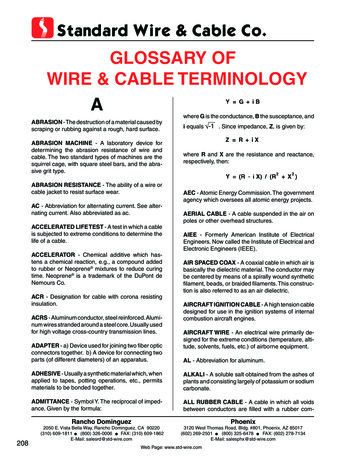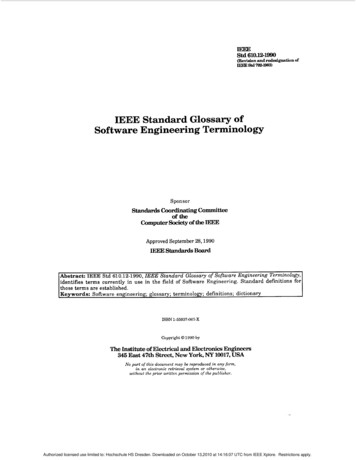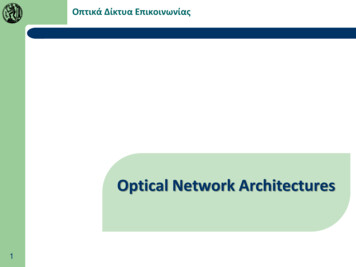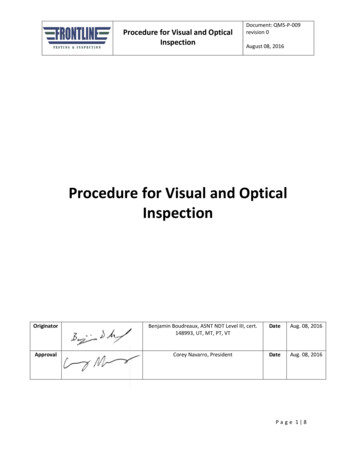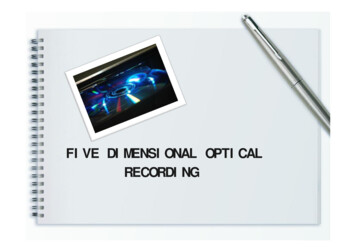
Transcription
Glossary ofOpticalTerminologywww.feaind.com800.327.2002
Glossary of Optical TerminologyAΛAllowance, vertex powerSymbol for prism.When following a number, it denotes the unitsknown as prism diopters.The amount by which the front surface curvature ofa lens must be flattened in order to compensate fora thickness-related gain in powerAngle, apicalAHorizontal dimension of the boxing systemrectangle that encloses a lens or lens opening.AcceleratorAn additive to a polishing slurry that is used toincrease the efficiency of the slurry.Accurate sag formulaSee Formula, accurate sag.Actual powerSee Power, actual.Adapter, offset blockA small metal device used on a lens that has beenblocked off center.It is used for the purpose of transferring pressureback to the center of the lens so that unwantedprism may be avoided.AddSee Addition, near.Addition, nearThe power that a lens segment has in addition tothat power already present in the main portion ofthe lens.Alignment, standardAn impersonal standard, independent of facialshape, for the alignment of spectacle frames.The angle formed by the junction of two nonparallelprism surfaces.Angle, effective diameterThe angle from the zero-degree side of the 180degree line to the axis of the effective diameter.The angle is referred to by the letter X and ismeasured using the right lens.Angle of deviationThe difference between the angle of incidence andthe angle of refraction.Angle , pantoscopic1. In standard alignment, that angle by which theframe front deviates from the vertical (lower rimsfarther inward than upper rims) when the spectaclesare held with the temples horizontal.2. In fitting, that angle which the frame front makeswith the frontal plane of the wearer’s face when thelower rims are closer to the face than the upper rims(opposite retroscopic angle).(Synonym: Pantoscopic tilt.)Angle, retroscopicThat angle which the frame font makes with thefrontal plane of the wearer’s face when the lowerrims are farther from the face than the upper rims(opposite pantoscopic angle).(Synonym: Retroscopic tilt.)www.feaind.com800.327.2002Glossary was taken from “Understanding Lens Surfacing,”written by Clifford W. Brooks, O.D., and published by Butterworth-Heinemann.page 2
Glossary of Optical TerminologyAnisometropiaA condition in which one eye differs significantly inrefractive power from the other.Antireflection coatingSee Coating, antireflection.Antiscratch coatingSee Coating, antiscratch.ApertureAn opening or hole that admits only a portion oflight from a given source or sources.Aperture, lensThe portion of the spectacle frame thataccepts the lens(Synonym: Lens opening.)ApexThe junction point at which the two nonparallelsurfaces of a prism meet.AphakicA person whose crystalline lens has been removed.AsphericA nonspherical surface.An aspheric lens surface generally decreasesin power peripherally in order to correct foraberrations found in the periphery of a lens.Aspheric, full-fieldAn aspheric lens that begins its asphericity wherethe small central spheric region leaves off.It continues in its asphericity all the way to the edgeof the lens blank.Aspheric lenticularSee Lenticular, aspheric.AstigmatismThe presence of two different curves on a singlerefracting surface on or within the eye.This causes light to focus as two line images insteadof a single point.Axis, of a cylinderAn imaginary reference line used to specifycylinder or spherocylinder lens orientation andcorresponding to the meridian perpendicular tothat of maximum cylinder power.Axis, prismThe base direction of an ophthalmic prism,expressed in degrees.Axis, opticalThat line which passes through the center of a lenson which the radii of curvature of the front and backsurfaces fall.www.feaind.com800.327.2002Glossary was taken from “Understanding Lens Surfacing,”written by Clifford W. Brooks, O.D., and published by Butterworth-Heinemann.page 3
Glossary of Optical TerminologyBBBase upThe vertical dimension of the boxing systemrectangle that encloses a lens or lens opening.Back base curveSee Curve, back base.Back cutSee Cut, back.Back vertex powerSee Power, back vertex.Ball gaugeSee Gauge, ball.Bar gaugeSee Gauge, bar.BaseIn a prism, the edge of maximum surfaceseparation opposite the apex.Base curveSee Curve, base.Base downVertical placement of prism such that thebase is at 270 degrees on a degree scale.Base inHorizontal placement of prism such that thebase is toward the nose.Base outHorizontal placement of prism such that the base istoward the side of the head.Vertical placement of prism such that thebase is at 90 degrees on a degree scale.Baume degreesA system used to quantify the concentration of aslurry based on the specific gravity of the slurry; Be 145 - 145/SG, where SG specific gravity.BCDBoxing center distance.See Distance, boxing center. Be An abbreviation for degrees Baume .Bell gaugeSee Gauge, bell.BevelThe angled edge of the spectacle lens.Bevel, pinSynonym for safety bevel.Bevel, safety1. To remove the sharp interface between lens surfaceand the sharp point of the bevel apex.2. The smoothed interface between the lens surfaceand bevel surface and the smoothed lens bevelapex.Bevel, VA lens edge configuration having the form ofa V across the whole breadth of the lens edge.Bicentric grindSynonym for slab-off.www.feaind.com800.327.2002Glossary was taken from “Understanding Lens Surfacing,”written by Clifford W. Brooks, O.D., and published by Butterworth-Heinemann.page 4
Glossary of Optical TerminologyBifocalsBlank, roughLenses having two areas for viewing,each with its own focal power.A lens-shaped piece of glass with neither sidehaving the finished curvature.Usually the upper portion of the lens isfor distance vision, the lower for near vision.Both sides must yet be surfaced in order to bringthe lens to the desired power and thickness.Bifocal, blendedA bifocal lens constructed from one piece of lensmaterial and having the demarcation line smoothedout so as not to be visible to an observer.Bifocal, curved-topA bifocal lens having a segment that is roundin the lower portion and gently curved on thetop of the segment.Bifocal, ExecutiveAmerican Optical’s trade name for theFranklin-style bifocal.Bifocal, flat-topA bifocal with a segment that is round in the lowerhalf but flat on the top.Bifocal, FranklinA bifocal having a segment that extends the entirewidth of the lens blank.Bifocals, round segA bifocal with a segment that is perfectly round.The width of the segment is usually 22 mm, but maybe larger (usually 38 mm).Blank, finished lensA lens having both front and back surfacesground to the desired powers, but not yetedged to the shape of the frame.Blank geometric centerSee Center, blank geometric.Blank seg dropSee Drop, Blank seg.Blank seg insetSee Inset, blank seg.Blank, semifinished lensA lens with only one side having the desiredcurvature.The second side must yet be surfaced in order tobring the lens to its desired power and thickness.Blended myodiscSee Lens, blended myodiisc.BlockThat which is attached to the surface of a lensin order to hold it in place during the surfacingor edging process.Block markSee Mark, blockBlockerThe device used to place a block on the lensin order to hold the lens in place during thesurfacing or edging process.Blocking bodiesSurfacing blocks used in conjunction with pitch.Blocking, finishThe application of a holding block to an ophthalmiclens so that it may be edged to fit a frame.www.feaind.com800.327.2002Glossary was taken from “Understanding Lens Surfacing,”written by Clifford W. Brooks, O.D., and published by Butterworth-Heinemann.page 5
Glossary of Optical TerminologyBlocking, off-centerThe practice of placing the surfacing lens blockat the desired location for the major referencepoint of the lens.Off-center blocking does not grind prism fordecentration.Blocking, on-centerThe practice of placing the surfacing block at theblank geometric center of the lens and moving themajor reference point of the lens to its desiredlocation by grinding prism for decentration.Blocking, simplified on-centerThe practice of using sinesquared methods tomove the optical center horizontally.The surfacing block is centered horizontally,but positioned vertically above the seg top byan amount equal to the seg drop.Blocking, surfaceThe application of a holding block to an ophthalmiclens so that one side may be ground to the correctcurvature and polished.Blocks, glassA small, thick disk used to hold a glass lens in placeduring the surfacing process.Blocks, plasticA curved disk used to hold a plastic lens in placeduring the surfacing process.These blocks vary in diameter, but are normallylarger than glass blocks to prevent lens flex duringprocessing.Box-o-GraphA flat device containing grids and slides used in themeasurement of pattern and edged lens size.Boxing centerSee Center, boxing.Boxing center distanceSee Distance, boxing center.Boxing systemSee System, boxing.BridgeThe area of the frame front between the lenses.Burn, polishingA lens surface defect that looks like a blister ora small group of blisters on the lens surface.Polishing burn may be the result of a polishing padthat has not been sufficiently wetted with polish.These are generally 43 mm in diameter and may beadapted for use in blocking plastic lenses.www.feaind.com800.327.2002Glossary was taken from “Understanding Lens Surfacing,”written by Clifford W. Brooks, O.D., and published by Butterworth-Heinemann.page 6
Glossary of Optical TerminologyCCCenter., readingThe horizontal width of a lens at a level halfwaybetween the two horizontal tangents of the top andbottom of the lens shape.(Synonym: Datum length.)CarrierThe optically unusable outer portion of alenticular lens that “carries” the opticallyusable central portion.CataractA loss in clarity of the crystalline lens of the eye,which results in reduced vision or loss of vision.Center, boxingThe midpoint of the rectangle that encloses a lensin the boxing system.Center, Blank geometricThe physical center of a semi-finished lens blankor an uncut finished lens blank.The blank geometric center is the center of thesmallest square or rectangle that completelyencloses the lens blank.Center, datumThe midpoint of the datum length (C dimension) of alens along the datum line.Center, geometric1. The boxing center.2. The middle point on an uncut lens blank.Center, opticalThat point on an ophthalmic prescription lensthrough which no prismatic effect is manifested.That point on a lens at the reading level thatcorresponds to the near PD.Center, seg opticalThat location on the segment of a bifocal lens thatshows zero prismatic effect when there is norefractive power in the distance portion of the lens.CentersThree short, replaceable, cylinder-shaped piecesthat fit into a surfacing block and serve as pivotpoints during fining and polishing.Centrad ( )A unit of measurement of the displacement oflight by a prism.One centrad is the prism power required todisplace a ray of light 1 cm from the position itwould otherwise strike on the area of a circlehaving a 1 m radius.CentrationThe act of positioning a lens for edging such that itwill conform optically to prescription specifications.Chart, prismA circular chart used to find the sum of twoprismatic effects graphically.This sum is expressed with the amount givenin prism diopters and the base direction givenin degrees.Charts, surfacingSynonym for surfacing tables.ChillerA refrigerator unit used for cooling generatorcoolant, fining or polishing slurry, or blockingalloy in the ophthalmic surfacing laboratory.www.feaind.com800.327.2002Glossary was taken from “Understanding Lens Surfacing,”written by Clifford W. Brooks, O.D., and published by Butterworth-Heinemann.page 7
Glossary of Optical TerminologyChordA straight line intersecting two points of an arc.Chord diameterSee Diameter, chord.Clock, segDesigned like a conventional lens measure exceptthat the three points of contact are closely spaced.Coating, antiscratchA thin, hard coating applied to plastic lens surfacesin order to make them more resistant to scratching.Coating, antireflectionA thin layer or series of layers of material appliedto the surface of a lens for the purpose of reducingunwanted reflections from the lens surface and thusincreasing the amount of light that passes throughto the eye.Collector, mistA vacuum system installed above the generatorgrinding chamber, which removed droplets ofgenerator coolant caused by the rapidly spinninggrinding wheel that would otherwise form a mist.ColmascopeAn instrument that utilizes polarized light to showstrain patterns in glass or plastic.Compensated lap toolSee Tool, compensated lap.Compensated padSee Pad, tool compensated.Compounding (of prism)The process of combining two or more prisms toobtain the equivalent prismatic effect expressedas a single prism.ConcaveAn inward-curved surface.Convergence1. An inward turning of the eyes, as whenlooking at a near object.2. The action of light rays traveling toward aspecific real image point.ConvexAn outward-curved surface.CoolantA recirculating liquid used to cool and lubricate thelens/grinding wheel interface during the grindingprocess.Coolant manifoldSee Manifold, coolant.Countersink curveSee Curve, countersink.Cover lensSee Lens, cover.CR-39A registered trademark of Pittsburgh Plate Glass Co.for an optical plastic known as Columbia Resin 39.It is the standard material from which conventionalplastic lenses are made.CribbingThe process of reducing a semifinished lensblank to a smaller size in order to speed thesurfacing process or reduce the probability ofdifficulty in surfacing.Cross curveSee Curve. cross.Cross fittingA reference point 2 to 4 mm above the majorreference point on progressiveaddition lenses.The fitting cross is positioned in front of the pupil.www.feaind.com800.327.2002Glossary was taken from “Understanding Lens Surfacing,”written by Clifford W. Brooks, O.D., and published by Butterworth-Heinemann.page 8 pa
Glossary of Optical Terminology Blocking, off-center The practice of placing the surfacing lens block at the desired location for the major reference point of the lens. Off-center blocking does not grind prism for decentration. Blocking, on-center The practice of placing the surfacing block at the blank geometric center of the lens and moving the major reference point of the lens to its .
